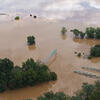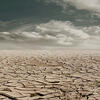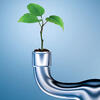From space, the Earth definitely lives up to it's nickname the "Big Blue Marble." That's because more than 70 percent of the Earth's surface is covered by water! It is essential to work with the world's water systems, not against them. There are various ways that we can help our water systems and improve sustainability. There are also important ways to prepare when the waters turn fierce, such as during flooding and severe weather.
Engineers Without Borders - USA builds a better world through sustainable engineering projects that empower communities to meet their basic human needs. The Engineers Without Borders Temple University Chapter was founded in 2009 and works on both local and international projects. EWB-Temple University’s most recent completed project was a water filtration and distribution system in Saccha, Peru. The project, started in November 2016 and completed in June 2019, brought much needed access to clean, potable water to a community of 24 people in a very remote region of the country.
Groundwater, the Hidden Resource
Water is essential to human, plant, and animal survival. From huge cities to tiny villages, about 50% of the world’s population depends on groundwater every day. Learn more in this video by the International Groundwater Resources Assessment Centre.
The Year of Groundwater
Making the Invisible Visible. 2022 was the UN year of groundwater. But what is groundwater, and how could it be one of the solutions to the climate crisis?
Mitigating Flood Risk in Pennsylvania

Mitigation is protecting what you value — people, your home, your belongings — from risk. The Federal Emergency Management Agency (FEMA) encourages community partners to identify, assess, and reduce risk through hazard mitigation planning and implementation. Flooding is the most common natural disaster in Pennsylvania, destroying thousands of homes and costing billions of dollars each year. We all have a role to play in helping to make Pennsylvania communities safer and more resistant to disaster. Identifying your community’s flood hazards and then acting to reduce those risks will result in a stronger, more resilient community.
Profiles in Resilience
In this video, FEMA highlights the value of flood mitigation action in three communities in order to increase community resilience. FEMA's mission is helping people before, during and after distasters. The FEMA Region III office, located in Philadelphia, oversees federal emergency management for Pennsylvania, Delaware, Maryland, Virginia, West Virginia, the District of Columbia, and seven Tribal Nations.
Our Shared Waters

The Delaware River is cleaner than ever. In fact, its cleanup is hailed as one of the world's top water quality success stories. But, the river still faces challenges to its sustainability as a public resource for drinking water, recreation and environmental habitat. Pollution due to chemicals, pesticides and herbicides is one of the primary threats, along with rising sea levels and flooding. Population growth and development can also negatively impact water resources. “Our Shared Waters: A Look at the Delaware River Basin” is an effort of Delaware River Basin stakeholder groups to educate the public and decisionmakers about the current state of the Basin and the opportunities available to support its continued sustainability now and for future generations. Be sure to explore the crowd-sourced water quality monitoring map for the Delaware River Basin.
PrepTalks: Jan Peelen “Living with Water: How the Netherlands Prevents Flood Disasters”
In this PrepTalks video from FEMA, Jan Peelen, Representative of the Dutch Ministry for Infrastructure and Water Management at the Embassy of the Kingdom of the Netherlands, tells the story of the Netherland’s historic battle with flooding and shares how the Dutch are learning to live with water. He advises U.S. entities on the topics of resilience, urban planning and infrastructure.
Disaster Dodgers: Severe Weather
This video from the Federal Emergency Management Agency (FEMA) teaches children what to do in different types of severe weather — such as tornadoes, hurricanes, and extreme heat or cold — and what they can do to prepare.
Rivers: Life of A River
Rivers have a life. They change the land through which they flow. They give us water to drink, energy we convert to electricity, and a place for plants and animals to live. But where do they start? How do they change? Take a ride on a river and find out more about this force of nature in this video from Science Trek.
Fresh Water Scarcity: An Introduction to the Problem
Fresh water is essential for life - and there's not nearly enough of it for the world right now. Why is that, and what could we do? In this video from TED-Ed, Christiana Z. Peppard lays out the big questions of our global water problem. And no, shorter showers are not the answer.
Water Underground - Empower
How far do you have to go to get a glass of safe drinking water? On average, women in Mozambique, Africa, spend between six and eight hours every day walking to fetch water - often that water is dirty. Do the math. That equals about three months out of 12 months every year. In this video, Water Underground poses the question if you have clean water, what will you do with those three months back?
UN Water - Water Scarcity

Water scarcity can mean scarcity in availability due to physical shortage, or scarcity in access due to the failure of institutions to ensure a regular supply or due to a lack of adequate infrastructure. Water scarcity already affects every continent. Water use has been growing globally at more than twice the rate of population increase in the last century, and an increasing number of regions are reaching the limit at which water services can be sustainably delivered, especially in arid regions. Get the facts about water scarcity from UN Water.
Using Less Water: A How-to Guide

It seems like water is all around us — but did you know that only one percent of the water on our planet is available for drinking? About 97 percent of Earth’s water is saltwater, and another two percent is frozen in ice caps and glaciers. Our world’s population, along with our need for clean freshwater, is growing, but our water supply is not. According to the United Nations, about two billion people are currently living in areas facing serious water scarcity. By 2040, it is estimated that one in four of the world’s children under 18, or 600 million, will be living in areas of extremely high water stress. Our water enables us to run our businesses, protect our communities and keep ourselves alive, so it is critical that we work to reduce water usage in our everyday lives. In this guide from the Academy of Natural Sciences, learn some essential, and often simple, was to use less water! Small actions spark big changes!
What's Our Impact on Freshwater Species Been?
Healthy rivers, lakes and wetlands provide huge benefits to people around the world – for farming, industry, drinking water and more. And they are a home for around 1 in 10 known animals. Despite all this, according to this video from World Wildlife Foundation International freshwater biodiversity is declining far faster than that in our oceans or forests.
Ocean Acidification
Oceans have a critical role in protecting the Earth but are threatened by greenhouse gas emissions such as carbon dioxide. Some of the carbon dioxide emitted into the atmosphere eventually mixes with seawater and forms acid. This process over time has made ocean water more acidic. Ocean acidification harms shell-forming marine organisms such as plankton, mussels and crabs and reduces the amount of seafood available for humans to consume. The U.S. Environmental Protection Agency is collecting ocean acidification data in order to better understand the problem and to help protect human health and the environment. You can help reduce ocean acidification through conservation and recycling. Visit here for more information about ocean acidification.
How to Save Our Planet
In this video from World Wildlife Foundation International, Sir David Attenborough explains how humans can take charge of our future and save our planet.

